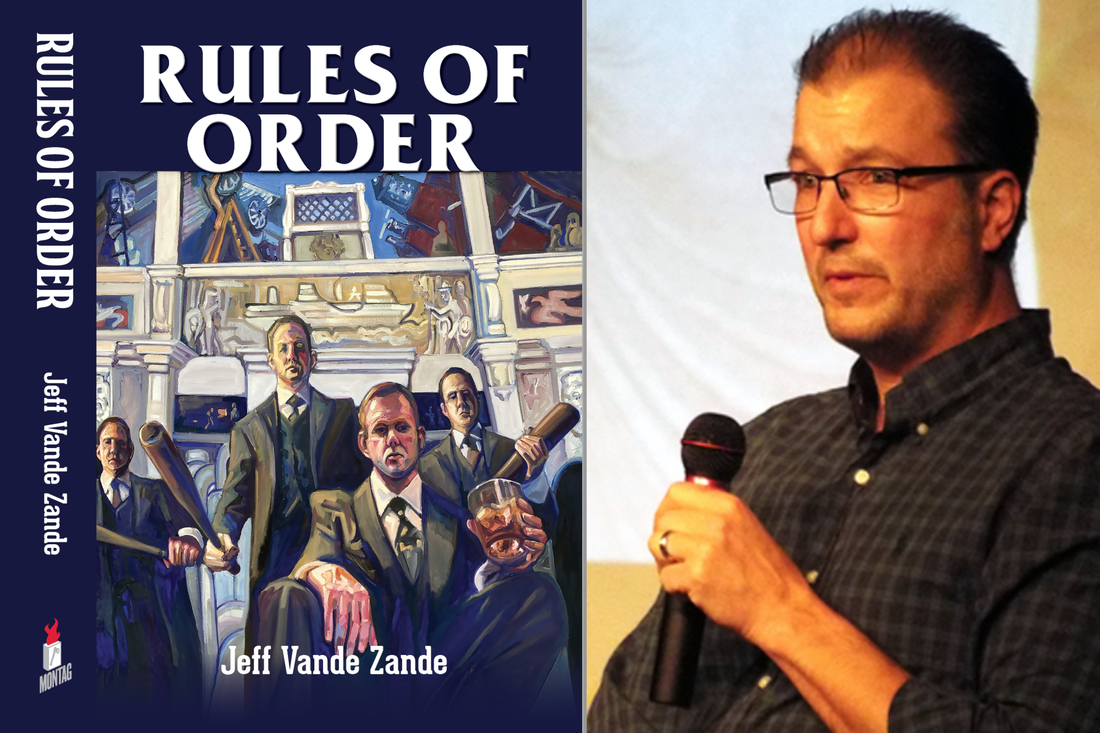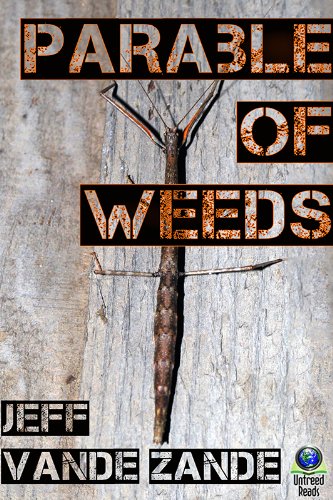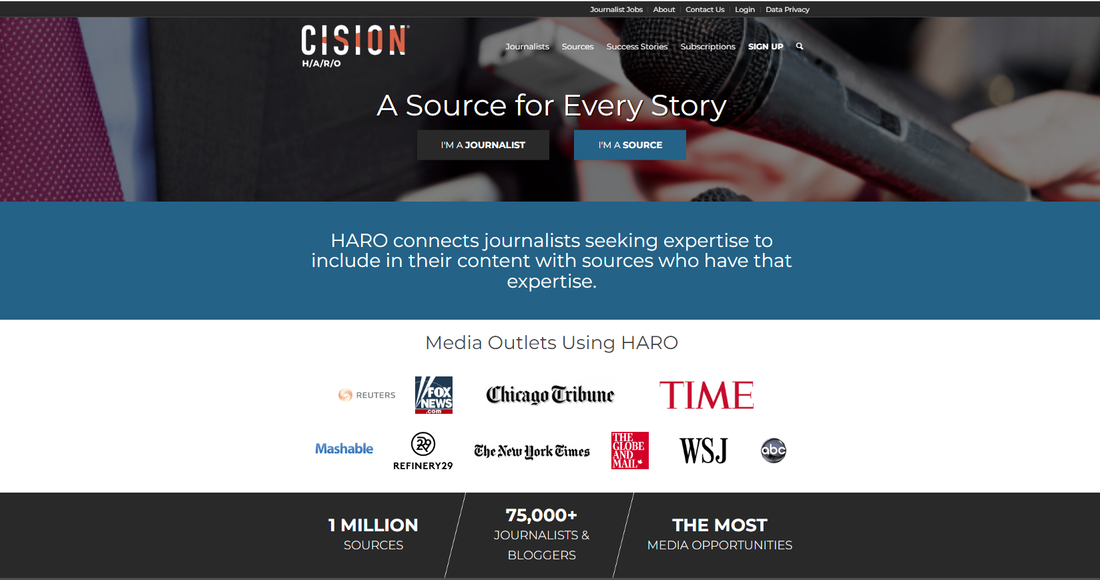|
Rules of Order, the latest offering from Jeff Vande Zande, evokes an eerie feeling of déjà vu for more than one reason. Firstly, it features a group of people forced to live together who can’t agree on, well, anything. Sound familiar? It’s like a real-life depiction of current events set against a dystopian backdrop. Secondly, fans that have read his previous work, The Neighborhood Division, recognize the characters and the storyline. The overarching theme in that collection of stories focused on battling with the instincts of the self vs. the community. One of the stories called “Load” left readers wanting more. Not one to leave his fans hanging, Vande Zande fulfilled their wishes by expanding the short into its own novel. In the shorter version, readers are introduced to the main character, Harvey Crowe. He has good intentions but struggles a bit with the execution. When we meet Crowe again in Rules of Order, he’s still busy trying to convince his neighbors that they must get on board with strict guidelines for weight limits in their individual apartments to protect the entire building from collapse. Although this time around, we gain more insight into his motives. If you’re asking why they couldn’t just move to a new building, readers get the impression that’s not an option in this dystopian future. Readers aren’t told exactly how it happened, but we’re led to believe that leaving the building and venturing into the outside world is akin to an immediate death sentence. It’s effective storytelling that Vande Zande leaves it up to the reader to fill in the blanks on how the outside world became so inhospitable to human life. “The bigger message I wanted to convey is that it was probably a good dose of capitalism that destroyed the outside world, and somehow, capitalism still found a way inside the building,” said Vande Zande. “It just became a microcosm of how the planet used to conduct itself. We want more for ourselves as individuals, even if we’re hurting the group.” The sky is falling…literallyWithout spoiling the storyline, it’s safe to say for most of the novel, Vande Zande taps into the reader’s anxiety with a sense of urgency about when – not if – the building will collapse. This sense of impending doom led to Falling Sky as the original title of the novel. “It was titled Falling Sky for a long time,” said Vande Zande. “But the publisher eventually decided it was too close to some other movie and book titles and that because of it, it just wasn’t grabbing him.” Vande Zande started brainstorming a new title and kept coming back to Robert’s Rules of Order, which he used as a frequent reference when writing the board room scenes for the book. “I thought about making the new title Rules of Order and the publisher loved it.” Of course, with Vande Zande, there always is a hidden meaning behind his book titles. Not only is Rules of Order a nod to Robert’s Rules, but it also is a play on words for how the order of society – rich vs. poor – was conducted within the building. The book title isn’t the only aspect of Rules of Order with a double entendre. Characters’ names also carried hidden meanings. One such character is the well-to-do Gerald LaMark, one of the newest and youngest members of the apartment building board. Vande Zande said he named LaMark after the character Lamarque in Les Miserables. “It’s kind of an homage to him because there’s a line in one of the songs that only Lamarque speaks for we people here below,” said Vande Zande. “It seemed a good parallel since LaMark speaks for the residents on the lower floors of the building.” Two of the most interesting characters in the book are the building supervisor, Sam, and his wife, Anya. Unfortunately for Crowe, he can hear every conversation the couple has through a leaky ventilation pipe between their apartments. Most of those arguments are about how much they dislike each other. “Some readers have shared with me that the super and his wife represent the oversharing that happens on social media these days,” said Vande Zande. “For me, they represent the existential threat of nuclear weapons that we can’t control among all the things that we try to do to protect ourselves and our planet. The whole planet can get annihilated only on our inability to get along.” It’s hardly a surprise the building in Rules of Order is an analogy for our planet. The world is facing an ongoing climate crisis, divisiveness, and authoritarianism – all things represented within the microcosm of Crowe’s building. Sam and Anya represent the overarching feeling that we’re in the palm of a hand we can’t control and that can crush us at any moment no matter what insignificant actions we take to prevent our demise. “The more we try, the harder we fail,” said Vande Zande. “We’re really botching it as a species.” Looking toward the futureReaders who enjoy The Rules of Order also may want to check out Vande Zande’s 50-page novelette, Parable of Weeds, which discusses the nuances of gated communities.
It may be a while before fans of Vande Zande’s brand of dystopian writing have a new story to immerse themselves in. After writing two novels in 2020, Vande Zande said he needs some time to restore his creative juices. Not to worry, though. He’ll be back to taking aspects of the real world, turning the volume up on them, and creating an amazing tale again in the future. For now, readers can get their copy of Rules of Order on Amazon.
0 Comments
Building brand authority requires creating quality content that establishes your credibility. Think of it as street cred for the internet. Many organizations struggle with this part of establishing their bona fides because they try to take a short cut with their content creation. They get sucked into the game of producing SEO keyword stuffed drivel that prioritizes search engines over the humans reading it. It’s nearly impossible to shape a stellar impression of your brand if visitors to your website and social media feeds are greeted by inferior content. Google finally has realized the error of its algorithm’s ways and has set out to correct course. By now, most people have heard about Google’s Helpful Content Update. If you’re among the few who missed the newsflash, here’s the long and short of it: Google is going to start rewarding content that puts people first, not search engines. Good thing for me that my business motto is, “People First. SEO Second.” I’ve always put readers first when writing content for myself or any of my clients. Getting people to your website or other online content is only the first part of the battle. If your content sucks, they won’t stick around (or come back) for more. Building brand authority takes time and skill. One of the tools in your growth strategy should include HARO. We’ll talk more about that later. First, let’s break down why you should care about brand authority. What is brand authority?Brand authority is all about trust. Not just trust in your product or service, either. Brand authority should extend to include how your current and prospective customers view your organization as a trustworthy source of information. You may have heard branding strategists and other marketing professionals talk about establishing yourself as an industry leader or niche authority. That’s just a fancy way of saying when you post something online, people believe it. Let’s say you’re a physical therapist with a large customer base and online presence. If you create a social media post about a new product to help with stretching that can reduce the risk of injury, your followers won’t doubt your recommendation because they believe you’re an expert on the matter. That’s brand authority. Why do I need to build brand authority?Organizations that want to be successful care about brand authority. If no one trusts your brand or has doubts about buying your products or services, they’re going to spend their money elsewhere. Trust goes beyond encouraging people to try your brand. It’s a critical component of keeping customers once you have them in the fold. Brand authority mustn’t be confused with brand awareness. You can know a brand exists, but that doesn’t necessarily mean you want to buy their products. An organization can be stellar at getting their name and products out there. However, that doesn’t mean they have a good product or service that people trust and rely on. Unilever is a great example of brand authority. Under former CEO Paul Polman, the company redirected its focus from profitability to sustainability. The result was a positive social impact through its Unilever Sustainable Living Plan that reinforced the company’s business integrity and resonated with consumers. Although its focus wasn’t on profitability, Unilever managed to increase its earnings over the eight years it spent concentrating on profit through purpose. What is HARO?As previously mentioned, HARO is one of the most effective ways to build brand authority. If you’re wondering what the heck HARO is, let me explain. Help A Reporter Out – HARO for short – pairs journalists and other media outlets with reputable sources they can quote in their articles. Media outlets like ABC News, Chicago Tribune, Fox News, Reuters, The New York Times, Time, and Wall Street Journal all rely on HARO to find industry experts for their articles. You must sign up for a membership to reap the benefits but it’s worth the effort. There are four membership levels from which to choose:
How does HARO build brand authority?Now that you know what HARO is, you’re probably wondering how you can use it to build brand authority. It’s quite simple. Depending on the plan you’ve chosen, start looking for opportunities that fit your niche. Let’s say you’re a pediatrician interested in growing your practice. You could use HARO to find opportunities to speak to local reporters about health and wellness issues affecting children. Once you see a good fit, submit a response to their query through the platform and wait to see if they select you. The Write Reflection™ has had great success getting clients featured as industry experts using HARO. We’ve matched brands with journalists from high authority web domains, bloggers, and sites with the most interactive followers. Tips for increasing your chancesAs you can probably imagine, there are a lot of brands vying for attention on HARO. You must find a way to help your brand stand out in a crowd if you want to be chosen as the industry expert. Here are some tips for making it happen:
How do I use HARO to build brand authority?It’s all about the backlinks, baby. A lot of organizations take short cuts when trying to get backlinks, including using Black Hat SEO techniques. Quick results can end up hurting your brand authority in the long run. It’s best to avoid them and build links the right way. Some HARO journalists and media outlets provide backlinks to your business website or other online presence in their stories once published. Known as an earned backlink, it redirects their readers to your website or social media accounts to learn more about you. Not only can you use HARO to establish yourself as a brand authority, but you also can use it to boost your SEO rankings with Google the right way. It’s a win-win! How do I get started with HARO?While it’s entirely possible to set up your own account and pitch yourself to reporters in HARO, you might want to consider hiring a professional to help you navigate the platform to increase your chances of success.
The Write Reflection has helped other clients build brand authority using HARO and other reputable methods. Reach out today to schedule your no-obligation consultation. |
Categories
All
Archives
April 2024
|








